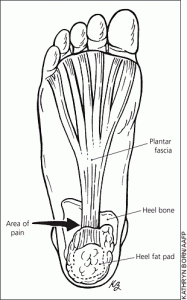
Maybe it’s not Plantar fasciitis but Heel Fat Pad Syndrome
Do you have heel pain? And think it is Plantar Fasciitis? Maybe not, it might be another type of heel pain known as; the Heel Fat Pad Syndrome.
What´s the difference between Plantar Fasciitis and Heel Fat Pad Syndrome?

As shown in the illustration, both structures are in the same area of the heel whereas the plantar fascia (illustrated as plantar aponeurosis) covered by the fat pad.
The plantar fascia attaches to the toes and forms the medial (longitudinal) arch of the foot. It provides static support of the medial arch and dynamic shock absorption.
The main functions of the fad pad are shock absorption of stress during heel strike (heel contact during walking).
While both the heel fat pad and plantar fascia can be a source for heel pain, the contributing factors, clinical signs and symptoms and management for them differ.
Heel Fat Pad vs Plantar Fasciitis
Plantar fasciitis is an overuse condition of the plantar fascia.
- Contributing factors: It oftens seen in people with foot deformities e.g. flat feet (low arches) or pes cavus (high arches). This deformity can lead to an excessive strain at the fascia during walking and hence cause pain. Other risk factors which can lead to increased stress in the fascia are inappropriate or non-supportive footwear, reduced ankle mobility, obesity and work-related weight-bearing.
- Clinical signs and symptoms: A typical clinical sign; swelling of the plantar fascia and can confirmed by ultrasound investigations. People with plantar fasciitis classically have a gradual onset of symptoms and feel their pain more on the inner side of the heel. Further symptoms are acute tenderness of the inner side of the heel, a tight plantar fascia and pain during stretching of the fascia. Especially the first steps in the morning or after rest are painful. The pain seems to decrease after a few minutes, and returns as the day proceeds and time on the feet increases.
- Management: Due to the tightness of the plantar fascia that leads to pain, treatments involve stretching and massaging to release the tight fascia and calf muscles. Other management includes avoiding aggravating activities (e.g. wearing heels), cold therapy (R.I.C.E), anti-inflammatory drugs, taping to relieve pain and lastly it is crucial to strengthen calf muscles that have weakened during the pain process. Some patients who are still symptomatic after conservative treatment might need surgery.
Heel Fat Pad Syndrome
Heel fat pad syndrome often caused by a decreased elasticity of the fat pad. A fall onto the heel from a height or chronically excessive heel strike with poor footwear can also lead to heel pain.
- Contributing factors: Increased age and weight decreases the elasticity of the fat pad.
- Clinical signs and symptoms: Compared to plantar fascitis, fat pad-related heel pain is felt more at the heel’s outer side, especially when the heel gets loaded (heel strike). MRI investigations will reveal changes in the fat pad showing signs of swelling.
- Management: Treatments aimed at unloading the heel by avoiding aggravating activities. The R.I.C.E. rule (Rest Ice Compression Elevation) should be applied and anti-inflammatory drugs are given in an acute situation. Further treatment includes taping, the use of a silicone gel heel pad and the use of appropriate footwear.
Experiencing ankle or feet pain? Find out more about physiotherapy and how our physiotherapist at Core Concepts Singapore can help resolve your feet pain.
References:
- Brukner, P & Khan, K 2007, Clinical Sports Medicine, 3rd edition, Tata McGraw Hill, Australia .
- Cole, C, Seto, G & Gazewood, J 2005, ‘Plantar Fasciitis: Evidence-Based Review of Diagnosis and Therapy`, American Family Physician, vol. 72, no. 11, pp. 2237-42.
- Thomas, JL, Christensen,, JC, Kravitz,, SR, Mendicino, RW, Schuberth, JM, Vanore, JV, Weil, LS, Zlotoff, HJ, Bouche, R & Baker, J 2010, ´ The Diagnosis and Treatment of Heel Pain: A Clinical Practice Guideline–Revision 2010`,The Journal of Foot & Ankle Surgery, vol. 49, pp. 1-19.
Related Articles
- Plantar Fasciitis - Pain In The Heel! What is plantar fasciitis? Plantar fasciitis is a foot pain condition and a term given for the painful and inflamed…
- Knee Pain: Fat Pad Irritation or Hoffa’s Syndrome Fat pad irritation (Hoffa’s syndrome) is a condition that falls under the broad umbrella of knee dysfunction leading to…
- Shin Splints – Medial Tibial Stress Syndrome: What… Approximately 10-20% of all runners will experience shin splints or medial tibial stress syndrome (MTSS) once in their career. Apart…
- Do I Need Arch-Supports? "Hi, I had thought you only needed arch-supports for your feet if you have flat feet. I checked with the…
- Pes Anserinus Tendinitis: The Main Cause Of Medial… More Singaporeans are taking part in endurance runs. Therefore, the number of people complaining about knee pain is also increasing.…
